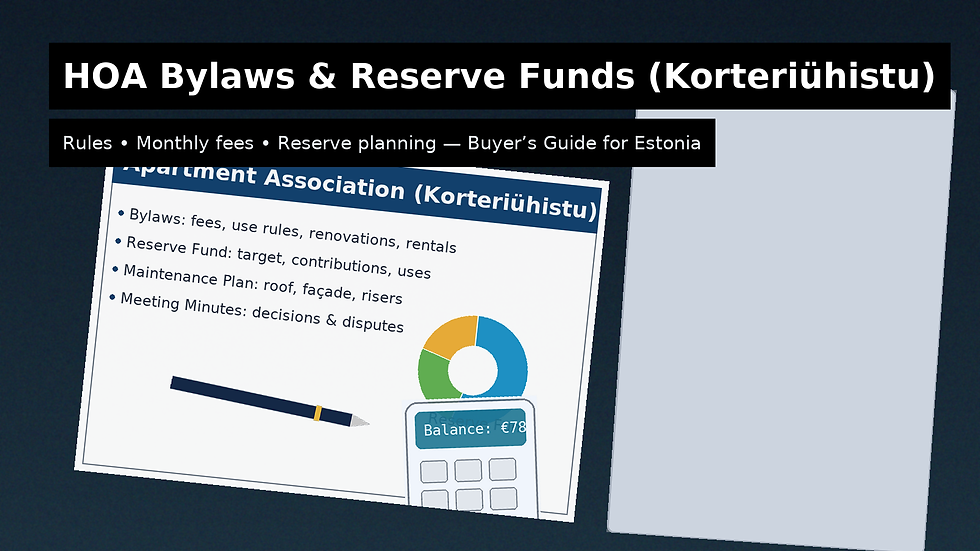Land Register Title & Encumbrances (Kinnistusraamat): How to Read It When Buying Properties in Estonia
- John Philips

- Sep 4
- 4 min read

Why the Land Register matters
The Kinnistusraamat (Estonian Land Register) is the single source of truth for real estate title. If it isn’t in the register, treat it as not real—promises, marketing brochures, and verbal agreements don’t beat registered rights. Reading the extract correctly protects you from surprise easements, lingering mortgages, or pre-emption rights that can derail a deal when buying properties in Estonia.
Quick glossary (plain English)
Extract: the official snapshot of a property’s registered data at a given time.
Rank/Priority: order in which rights (e.g., mortgages) take effect. First rank beats all later ranks.
Encumbrance: any burden on the property (servitudes, superficies, usufruct, restrictions).
Pending entry/annotation: something is in progress (e.g., a mortgage or right being registered). Treat as a risk until finished or removed.
The extract structure—what each section means
Section I — Property
Cadastral ID, address, area, intended use, and sometimes plan annex references.
Checks: address matches the deal; area and use fit your plan; plan annex is available.
Section II — Owner
Legal owner(s), share fractions, acquisition basis (deed/date).
Checks: seller’s identity matches this section; all co-owners consent to sell; seller has the right to sell (no curator/guardianship surprises).
Section III — Encumbrances
Servitudes (easements): rights of way, utility corridors, access to shared roads, waterfront paths (kallasrada).
Right of superficies (hoonestusõigus): you may own the building but not the land; there’s ground rent and a term—read carefully.
Usufruct/personal rights: someone else may have the right to use the property (e.g., lifetime residence).
Restrictions/notes: heritage, environmental buffers, building limitations.
Checks: map servitudes on a plan; read any rent, term, consent, or renewal clauses; confirm practical access and utilities.
Section IV — Mortgages & Liens
Creditor, amount, and rank for each charge.
Checks: How will existing mortgages be released on completion? Make sure your lender gets first rank at closing if you’re financing.
Priority (rank) explained in 60 seconds
Rights are stacked in order. If the worst happens (e.g., enforcement), first rank gets paid first. When buying properties in Estonia, you typically require:
All old charges to be deleted at completion (seller pays them off), and
Your bank’s new mortgage to be registered in first rank (unless you’re cash).
Hidden pitfalls that catch buyers out
Pending entries/annotations: “registration in progress” can leapfrog your rights—resolve before signing.
Unmapped servitudes: the text says “right of way,” but no plan shows where. Demand a sketch/plan.
Superficies reversion: building may revert to landowner at term end—price the risk and check renewal terms.
Pre-emption rights (e.g., co-owners/municipality): they can step into your shoes—know the period and process.
Multiple owners/estates: all must sign; watch for probate/estate administration.
Buyer due-diligence checklist (copy/paste)
☐ Fresh Land Register extract for the exact unit/plot (plus plan annex)
☐ Seller = registered owner, all co-owners consenting
☐ Encumbrances understood: servitudes mapped, any personal rights timed/waived
☐ Superficies (if any): term, ground rent, indexation, renewal/reversion rules
☐ Pre-emption rights identified; waiver/notice process agreed
☐ Mortgages/liens: deletion undertakings and payoff letters arranged
☐ No pending entries that could outrank you (or a plan to resolve before completion)
☐ Utilities & access secured via servitudes where needed (driveway, water, sewer, power, fibre)
☐ Insurance/heritage/nature restrictions checked if noted
Notary-day documents & clauses (copy/paste)
Deletion of charges: “Seller undertakes to procure deletion of all mortgages and liens at completion. Notary to apply simultaneously with transfer.”
Bank undertakings: attach the creditor’s payoff letter and deletion consent to the deed.
Pre-emption: “Seller confirms no party with pre-emption rights or, where applicable, waivers are attached as Annex X.”
Servitude plan: “Servitudes shall be shown in the annexed plan sketch and registered accordingly.”
Superficies (if applicable): attach ground-lease agreement; clarify indexation, consents, renewal, and reversion.
Long-stop: “If registration of Buyer’s title/mortgage is refused or delayed due to undisclosed entries, Buyer may rescind and recover sums.”
Encumbrances decoded (what they mean in practice)
Encumbrance | What it does | Buyer impact |
Right of way / utility servitude | Lets others pass or lay pipes/cables | Fine if mapped; avoid blocking routes |
Right of superficies | Separate land from building ownership | Understand term, ground rent, renewal |
Usufruct / habitation right | Someone can live/use the property | Value hit unless right is extinguished |
Pre-emption | Third party can buy on your terms | Build in notice/waiver timing |
Building restrictions | Limits materials, height, use | Check for renovation plans and costs |
Mortgages & deletions—make the sequence fool-proof
Seller gets a payoff statement and creditor deletion consent.
At the notary, your funds pay the lender; notary files simultaneous applications to transfer title and delete old charges.
Your bank’s new mortgage (if any) is registered in the agreed rank.
Keep the file number for follow-up until the registry confirms entries are updated.
Red flags (reprice or walk away)
Encumbrances that block access or utility routes you need.
Superficies with short remaining term and open-ended indexation of ground rent.
Pending entries you can’t clearly resolve before completion.
Lack of creditor consents to delete mortgages.
Pre-emption that can’t be waived in your timescale.
FAQs
Is the Land Register extract enough on its own?
It’s essential, but pair it with the plan annex and a site/utility check so servitudes match physical reality.
Can I rely on the seller’s old extract?
Always order a fresh extract near signing—entries can change daily.
Do banks accept superficies as collateral?
Often, yes—subject to term length, ground-rent terms, and landowner consents. Expect more scrutiny.
Bryan Estates: Title & Encumbrance Pack
Plain-English title memo with mapped servitudes
Superficies term and ground-rent modelling
Notary-day clause pack (deletions, pre-emption, servitude plans)
Coordination of creditor undertakings for clean transfer
Need a fast title read-through?
Email info@bryanestates.ee or call +372 123 4567. We’ll decode the extract and help you move decisively when buying properties in Estonia.



Comments